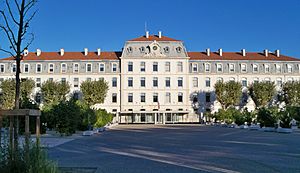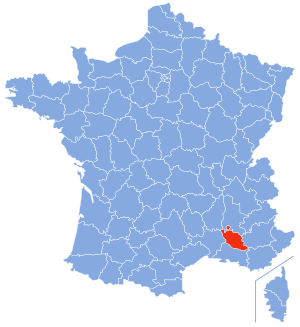Vaucluse facts for kids
Quick facts for kids
Vaucluse
|
|||
|---|---|---|---|

Prefecture building of the Vaucluse department, in Avignon
|
|||
|
|||

Location of Vaucluse in France
|
|||
| Country | France | ||
| Region | Provence-Alpes-Côte d'Azur | ||
| Département | 4 March 1790 | ||
| Prefecture | Avignon | ||
| Subprefectures | Apt, Carpentras | ||
| Area | |||
| • Total | 3,567.3 km2 (1,377.3 sq mi) | ||
| Population
(2014)
|
|||
| • Total | 554,374 | ||
| • Rank | 48th | ||
| • Density | 155.4044/km2 (402.495/sq mi) | ||
| Demonym(s) | Vauclusiens | ||
| Time zone | UTC+1 (CET) | ||
| • Summer (DST) | UTC+2 (CEST) | ||
| ISO 3166 code | FR-84 | ||
| Arrondissements | 3 | ||
| Cantons | 17 | ||
| Communes | 151 | ||
| Website | http://www.vaucluse.fr/ | ||
Vaucluse is a special area in the southeast of France. It is called a department. It is part of the Provence-Alpes-Côte d'Azur region. The main city and capital of Vaucluse is Avignon.
The department gets its name from a famous spring in the town of Fontaine-de-Vaucluse. The name Vaucluse comes from the Latin words Vallis Clausa. This means "closed valley". The valley here ends at a cliff where the spring begins.
Contents
History of Vaucluse
Vaucluse was not one of the first 83 French departments. These were created during the French Revolution on March 4, 1790. Vaucluse was formed later, on August 12, 1793.
It started with four areas called districts: Apt, Orange, Ouvèze (Carpentras), and Vaucluse (Avignon). Avignon was chosen as its capital.
Changes Over Time
In 1800, France created new administrative areas called arrondissements. The old districts became the arrondissements of Avignon, Apt, Carpentras, and Orange.
After the Battle of Waterloo in 1815, the Austrian army took control of the department. They stayed from June 1815 to November 1818.
Later, in 1926, the Orange arrondissement was removed. The subprefecture of Apt moved to Cavaillon for a short time. But it returned to Apt in 1933.
Geography of Vaucluse
Vaucluse is located in the southeast of France. It is part of the Provence-Alpes-Côte d'Azur region. The department covers an area of about 3,567 square kilometers (1,377 square miles).
A unique part of Vaucluse is an exclave to the north. This is the canton of Valréas. It is completely surrounded by the Drôme department.
Neighboring Areas
Vaucluse shares borders with three other regions and six departments:
- Occitanie region:
- Gard (to the west)
- Auvergne-Rhône-Alpes region:
- Provence-Alpes-Côte d'Azur region:
- Alpes-de-Haute-Provence (to the east)
- Var (a small border to the southeast)
- Bouches-du-Rhône (to the south)
 |
Ardèche | Drôme |  |
|
| Gard | Alpes-de-Haute-Provence | |||
| Bouches-du-Rhône | Var |
Mountains and Plains
Vaucluse has several mountain chains, mostly in its eastern part. These include:
- Dentelles de Montmirail: A small mountain chain. Its highest point is Crête de Saint-Amand, which is 730 meters (2,395 feet) high.
- Vaucluse Mountains (French: Monts de Vaucluse): The highest peak in this chain is Signal de Saint-Pierre, at 1,256 meters (4,121 feet).
- Luberon Massif: Located in the southeast. Its highest point is Mourre Nègre, at 1,125 meters (3,691 feet). This area is part of the Regional Natural Park of Luberon.
The tallest mountain in the entire department is Mont Ventoux. It stands 1,911 meters (6,270 feet) high. Mont Ventoux is a standalone mountain. It is north of the Luberon range and east of the Dentelles de Montmirail.
The department also has several valleys and plains. The most important plain is the plain of Comtat. Most of the people in Vaucluse live here. This plain is located south and west of Mont Ventoux. The Rhône river is to its west, the Durance river to its south, and the Vaucluse Mountains to its east.
The main rivers are the Rhône and the Durance. The Durance is a tributary (a river that flows into another) of the Rhône. Other rivers in Vaucluse also flow into these two main rivers.
Climate in Vaucluse
The climate in Avignon, which is 56 meters (184 feet) above sea level, is a Mediterranean climate. This means it has hot, dry summers and mild, wet winters.
The average yearly temperature in Avignon is 14.4°C (57.9°F). July is usually the warmest month, with an average of 23.3°C (73.9°F). January is the coolest, averaging 5°C (41°F).
Avignon gets about 617.2 millimeters (24.3 inches) of precipitation (rain or snow) each year. October is the wettest month, with about 83.8 millimeters (3.3 inches) of rain. January is the driest, with only about 22.9 millimeters (0.9 inches).
Administration of Vaucluse
Vaucluse is part of the Provence-Alpes-Côte d'Azur region. The department is managed by the Departmental Council of the Vaucluse. This council is located in Avignon.
Administrative Divisions
Vaucluse is divided into smaller areas to help with its management:
- 3 arrondissements (districts)
- 17 cantons
- 151 communes (municipalities or towns)
| INSEE code |
Arrondissement | Capital | Population (2014) |
Area (km²) |
Density (Inh./km²) |
Communes |
|---|---|---|---|---|---|---|
| 841 | Apt | Apt | 128,448 | 1,377.2 | 93.3 | 56 |
| 842 | Avignon | Avignon | 296,303 | 923.7 | 320.8 | 37 |
| 843 | Carpentras | Carpentras | 129,623 | 1,266.4 | 102.4 | 58 |
Here is a list of the 17 cantons in Vaucluse. These were reorganized in March 2015:
- Apt (8401)
- Avignon-1 (8402)
- Avignon-2 (8403)
- Avignon-3 (8404)
- Bollène (8405)
- Carpentras (8406)
- Cavaillon (8407)
- Cheval-Blanc (8408)
- L'Isle-sur-la-Sorgue (8409)
- Monteux (8410)
- Orange (8411)
- Pernes-les-Fontaines (8412)
- Pertuis (8413)
- Le Pontet (8414)
- Sorgues (8415)
- Vaison-la-Romaine (8416)
- Valréas (8417)
People of Vaucluse
The people who live in Vaucluse are called Vauclusiens (for men) and Vauclusiennes (for women) in French.
In 2014, Vaucluse had a population of 554,374 people. This means there were about 155 people living per square kilometer. The arrondissement of Avignon is the largest, with 296,303 people. Carpentras has 129,623 people, and Apt has 128,448 people.
The biggest city in Vaucluse is its capital, Avignon, with 92,209 residents. The subprefectures, Carpentras and Apt, have 28,447 and 11,885 people, respectively.
Economy of Vaucluse
Vaucluse has always been a rural department. Farming is the most important economic activity here. The main things grown in Vaucluse are fruits and vegetables.
Some popular fruits include melons, cherries, strawberrys, apples, and grapes. Common vegetables include tomatoes.
Another important product from this region is wine. Many of these wines are known as Côtes-du-Rhône wines.
Related pages
Images for kids
-
Pont Saint-Bénezet and Palais des Papes in Avignon
-
Gordes, one of the most beautiful villages of France
See also
 In Spanish: Vaucluse para niños
In Spanish: Vaucluse para niños









